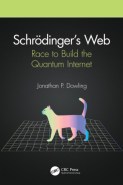‘Schrödinger’s Web’ offers a sneak peek at the quantum internet
A new book delivers an entertaining overview of the physics of light and quantum technology

In the future, networks of quantum computers may transmit entangled photons between each other, forming a quantum internet analogous to our classical internet.
Andrey Tolkachev/iStock/Getty Images Plus
Schrödinger’s Web
Jonathan P. Dowling
CRC Press, $40.95
When news broke last year that Google’s quantum computer Sycamore had performed a calculation faster than the fastest supercomputers could (SN: 12/16/19), it was the first time many people had ever heard of a quantum computer.
Quantum computers, which harness the strange probabilities of quantum mechanics, may prove revolutionary. They have the potential to achieve an exponential speedup over their classical counterparts, at least when it comes to solving some problems. But for now, these computers are still in their infancy, useful for only a few applications, just as the first digital computers were in the 1940s. So isn’t a book about the communications network that will link quantum computers — the quantum internet — more than a little ahead of itself?
Surprisingly, no. As theoretical physicist Jonathan Dowling makes clear in Schrödinger’s Web, early versions of the quantum internet are here already — for example, quantum communication has been taking place between Beijing and Shanghai via fiber-optic cables since 2016 — and more are coming fast. So now is the perfect time to read up.
Dowling, who helped found the U.S. government’s quantum computing program in the 1990s, is the perfect guide. Armed with a seemingly endless supply of outrageous anecdotes, memorable analogies, puns and quips, he makes the thorny theoretical details of the quantum internet both entertaining and accessible.
Readers wanting to dive right in to details of the quantum internet will have to be patient. “Photons are the particles that will power the quantum internet, so we had better be sure we know what the heck they are,” Dowling writes. Accordingly, the first third of the book is a historical overview of light, from Newton’s 17th century idea of light as “corpuscles” to experiments probing the quantum reality of photons, or particles of light, in the late 20th century. There are some small historical inaccuracies — the section on the Danish physicist Hans Christian Ørsted repeats an apocryphal tale about his “serendipitous” discovery of the link between electricity and magnetism — and the footnotes rely too much on Wikipedia. But Dowling accomplishes what he sets out to do: Help readers develop an understanding of the quantum nature of light.
Sign up for our newsletter
We summarize the week's scientific breakthroughs every Thursday.
Like Dowling’s 2013 book on quantum computers, Schrödinger’s Killer App, Schrödinger’s Web hammers home the nonintuitive truths at the heart of quantum mechanics. For example, key to the quantum internet is entanglement — that “spooky action at a distance” in which particles are linked across time and space, and measuring the properties of one particle instantly reveals the other’s properties. Two photons, for instance, can be entangled so they always have the opposite polarization, or angle of oscillation.
In the future, a user in New York could entangle two photons and then send one along a fiber-optic cable to San Francisco, where it would be received by a quantum computer. Because these photons are entangled, measuring the New York photon’s polarization would instantly reveal the San Francisco photon’s polarization. This strange reality of entanglement is what the quantum internet exploits for neat features, such as unhackable security; any eavesdropper would mess up the delicate entanglement and be revealed.
While his previous book contains more detailed explanations of quantum mechanics, Dowling still finds amusing new analogies, such as “Fuzz Lightyear,” a canine that runs along a superposition, or quantum combination, of two paths into neighbors’ yards. Fuzz helps explain physicist John Wheeler’s delayed-choice experiment, which illustrates the uncertainty, unreality and nonlocality of the quantum world. Fuzz’s path is random, the dog doesn’t exist on one path until we measure him, and measuring one path seems to instantly affect which yard Fuzz enters even if he’s light-years away.
The complexities of the quantum web are saved for last, and even with Dowling’s help, the details are not for the faint of heart. Readers will learn how to prepare Bell tests to check that a system of particles is entangled (SN: 8/28/15), navigate bureaucracy in the Department of Defense and send unhackable quantum communications with the dryly named BB84 and E91 protocols. Dowling also goes over some recent milestones in the development of a quantum internet, such as the 2017 quantum-secured videocall between scientists in China and Austria via satellite (SN: 9/29/17).
“Just like the classical internet, we really won’t figure out what the quantum internet is useful for until it is up and running,” Dowling writes, so people can start “playing around with it.” Some of his prognostications seem improbable. Will people really have quantum computers on their phones and exchange entangled photons across the quantum internet?
Dowling died unexpectedly in June at age 65, before he could see this future come to fruition. Once when I interviewed him, he invoked Arthur C. Clarke’s first law to justify why he thought another esteemed scientist was wrong. “The first law is that if a distinguished, elderly scientist tells you something is possible, he’s very likely right,” he said. “If he tells you something is impossible, he’s very likely wrong.”
Dowling died too soon to be considered elderly, but he was distinguished, and Schrödinger’s Web lays out a powerful case for the possibility of a quantum internet.
Buy Schrödinger’s Web from Amazon.com. Science News is a participant in the Amazon Services LLC Associates Program. Please see our FAQ for more details.








